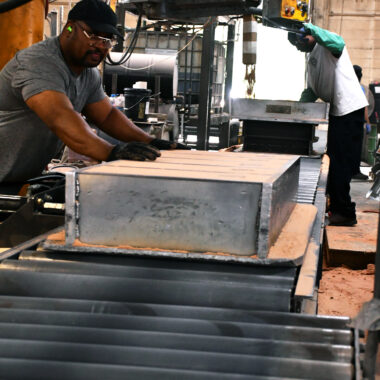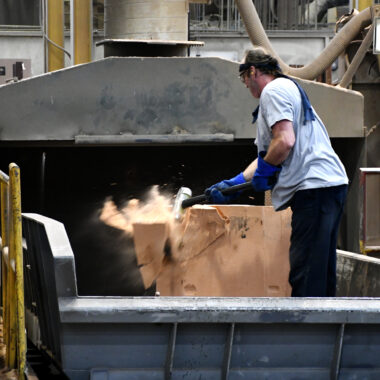Maximizing Performance: Processes in Casting Aluminum Illinois
Maximizing Performance: Processes in Casting Aluminum Illinois
Blog Article
The Art of Aluminum Casting: Enhancing Your Skills for Superior Outcomes
Light weight aluminum casting is a craft that requires accuracy, perseverance, and a deep understanding of the techniques entailed. As developers and craftsmens, our pursuit of quality in aluminum spreading is a journey that requires dedication and a constant pursuit for proficiency.
Background of Light Weight Aluminum Spreading
Aluminum spreading, a process with origins mapping back centuries, has actually played a significant function in the development of different industries. The history of aluminum spreading go back to the 19th century when it became a critical production method. The utilization of aluminum in casting processes changed industries such as vehicle, aerospace, and building because of its light-weight properties and deterioration resistance.
One of the earliest uses aluminum casting can be mapped to the manufacturing of pots and pans and attractive products. As innovations in modern technology occurred, aluminum casting increased its reach to include engine parts, structural parts for aircraft, and elaborate styles in building frameworks. The versatility and versatility of light weight aluminum spreading permitted the creation of detailed forms and styles that were formerly unattainable with various other making approaches.
Today, aluminum spreading remains to be a foundation of modern industrial processes, making it possible for the manufacturing of complicated elements with high accuracy and performance (casting aluminum illinois). Comprehending the historic development of aluminum casting supplies valuable understandings into its enduring value and constant development in the industrial landscape
Important Tools and Tools
Utilizing specialized devices and equipment is important in accomplishing optimal outcomes in the light weight aluminum spreading process. The basic tools required for light weight aluminum spreading include a crucible for melting the aluminum, a heater to reach the required temperature levels, and mold and mildews to shape the liquified steel.
In enhancement to these basics, specialized tools like ladles, tongs, and safety gear such as handwear covers and aprons are necessary for taking care of liquified metal securely. Ladles are utilized to move the molten light weight aluminum from the crucible to the mold and mildew, while tongs offer a protected hold on the hot products. Protective equipment is essential to stop injuries from the heats entailed in the casting process. On the whole, having the right tools and tools is extremely important for achieving top quality and specific aluminum spreadings.
Understanding the Casting Refine
Having actually gotten the essential devices and equipment for light weight aluminum spreading, the following step towards excellence exists in understanding the detailed spreading procedure. casting aluminum illinois. The spreading procedure involves a series of actions that require skill, interest, and precision to detail to ensure remarkable results

In addition, pouring the liquified light weight aluminum right into the mold should be done gradually and without disruption to prevent air entrapment or incomplete fills up. As soon as the light weight aluminum has strengthened, very carefully getting rid of the casting from the mold without creating any damages is critical. Lastly, post-casting processes such as cutting, sanding, and completing should be accomplished meticulously to attain the preferred final item. Understanding each step of the spreading process is crucial to generating top notch aluminum castings.

Advanced Techniques and Tips
Mastering detailed details and executing sophisticated techniques can raise the quality and accuracy of light weight aluminum spreading processes. One innovative technique is using ceramic molds, which supply a smoother surface area coating and higher dimensional precision compared to conventional sand mold and mildews. In addition, using vacuum cleaner spreading methods can help minimize porosity in the final casting, causing more powerful and much more sturdy aluminum parts.
One more tip is to pre-heat the mold and mildews prior to putting the molten light weight aluminum to boost the flowability of the metal and minimize the probability of problems such as chilly shuts or misruns. In addition, utilizing chill blocks purposefully can help control the solidification rate of the aluminum, decreasing interior anxieties and enhancing the total mechanical buildings of the actors part.
Last but not least, understanding the art of gating and risering is essential for attaining sound castings. Correctly developed gating risers and systems can assist prevent shrinking defects and make sure an attire circulation of visit their website steel throughout the mold cavity, leading to superior casting top quality. By integrating these advanced methods and ideas into your aluminum casting procedure, you can boost the consistency and accuracy of your end products.
Troubleshooting Common Spreading Issues
Dealing with usual casting issues requires an organized strategy to identify and fix elements impacting the quality of aluminum spreadings. One common problem is porosity, which results in little holes or gaps in the casting as a result of gas entrapment. This concern can be mitigated by effectively degassing the liquified light weight aluminum before casting and making sure adequate airing vent in the look at this web-site mold and mildew. One more usual difficulty is contraction defects, where the spreading contracts unevenly throughout cooling, causing splits or distortion. To resolve contraction, adjusting the gating system style and optimizing the riser placement can aid promote uniform solidification. Additionally, incorrect mold and try this out mildew dental filling can create issues like misruns or cold shuts, leading to insufficient castings. Enhancing eviction system, enhancing putting techniques, and making sure correct steel temperature are essential in stopping such defects. By comprehending these typical casting issues and carrying out reliable remedies, aluminum wheels can improve the overall high quality and stability of their spreadings.
Conclusion
In final thought, grasping the art of light weight aluminum casting calls for a deep understanding of the history, crucial tools, and progressed methods involved in the procedure. By developing your abilities and fixing usual spreading problems, you can accomplish remarkable cause your casting projects. Continuous technique and dedication are key to enhancing your capabilities and generating high-quality light weight aluminum castings.
Grasping each action of the spreading procedure is essential to creating premium light weight aluminum spreadings.
In addition, employing vacuum cleaner spreading approaches can assist decrease porosity in the final spreading, resulting in stronger and extra resilient aluminum components.
Addressing usual spreading concerns requires a methodical method to determine and correct variables impacting the quality of aluminum castings. By recognizing these typical spreading problems and applying effective services, light weight aluminum casters can enhance the general high quality and integrity of their spreadings.
By sharpening your abilities and fixing usual spreading problems, you can achieve remarkable results in your spreading tasks.
Report this page